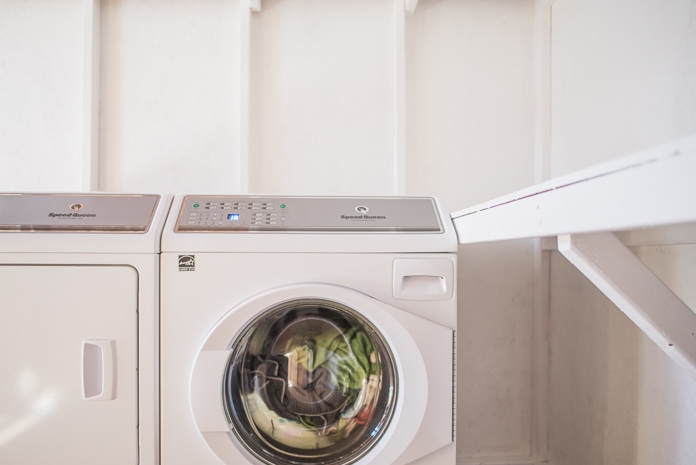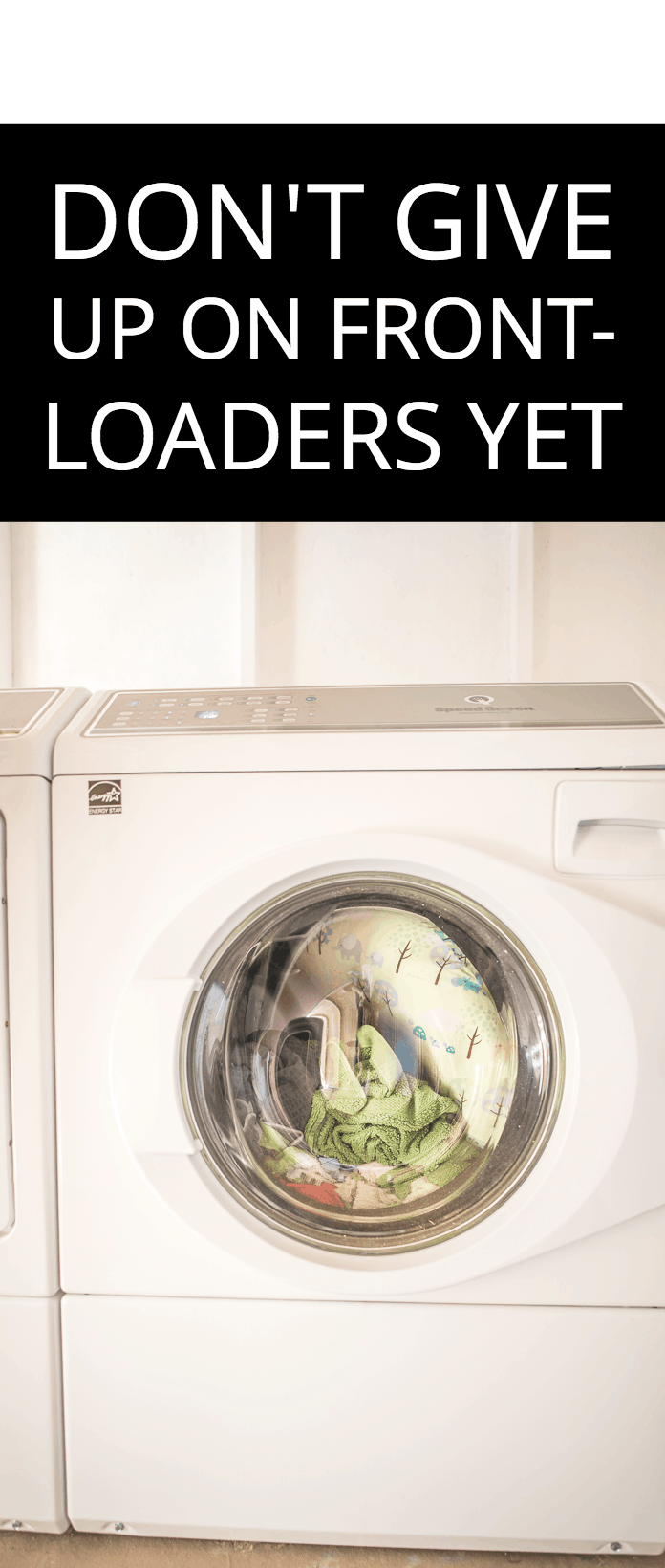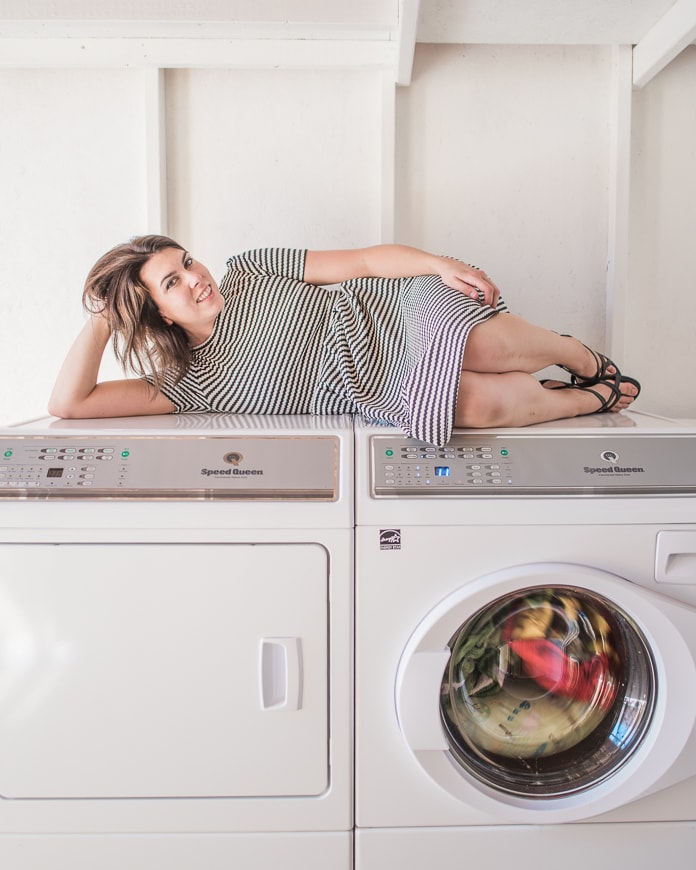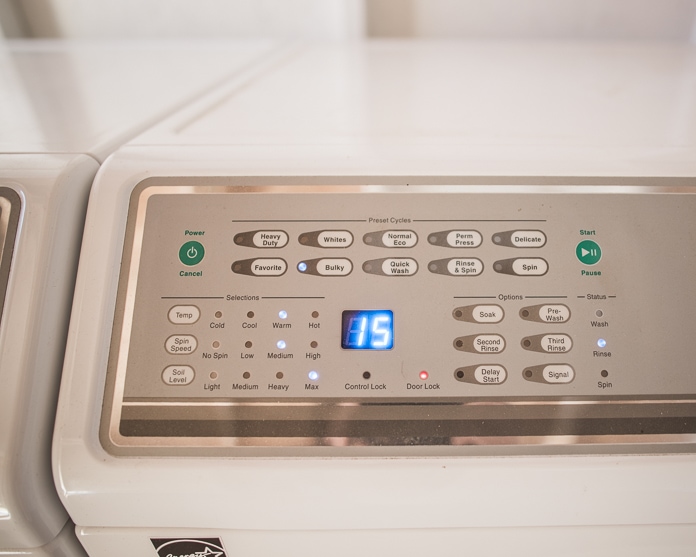We're still working on our outdoor laundry room, and I can't WAIT to unveil the final project and share how we made it happen from start-to-finish. In the meantime, we've received a few questions about top-loaders versus front-loaders. So let's get technical, shall we?
 Front-loaders are known for their energy efficiency, which is what draws many consumers to them initially. They also offer greater control over spin speed and use gravity as opposed to agitation to wash laundry, making them a bit gentler on clothes. They were pricey when they made a big splash in the marketplace around the early 2000's, but constantly-advancing technology has brought their cost down significantly since then. Today, the best top-loaders and front-loaders are often neck-in-neck in terms of affordability.
Front-loaders are known for their energy efficiency, which is what draws many consumers to them initially. They also offer greater control over spin speed and use gravity as opposed to agitation to wash laundry, making them a bit gentler on clothes. They were pricey when they made a big splash in the marketplace around the early 2000's, but constantly-advancing technology has brought their cost down significantly since then. Today, the best top-loaders and front-loaders are often neck-in-neck in terms of affordability.
Some people (myself included) have had nightmarish ordeals with front-loaders, though, experiencing noisy spin imbalance and the dreaded drum mold. I'd personally sworn off front-loaders and vowed that all my future machines would be top-loaders…that is, until I had a long conversation with our sponsor Speed Queen about it.
Here's how they changed my mind.
Overcoming the Yick Factor
First and foremost: the mold issue needs to be addressed. After dealing with disgusting buildup and odor issues in our previous machine from a different manufacturer, I was super-wary about this point. It was nearly impossible to ditch that scum once it started, and all of my clothes came out smelling gross in that machine. “Never again!” I declared. Speed Queen convinced me to slow my roll, explaining that their stainless steel wash tub doesn't collect mold. The plastic ones from other manufacturers are the issue.
I offered up some major side-eye at that explanation, and then proceeded to wash 100+ loads of laundry over three months in the machines they gave me. I often forget about loads mid-wash and leave them for days at a time (hi, I have four kids) and I haven't encountered the slightest bit of mold or mildew.
I'm astonished. My faith in front-loaders has officially been RESTORED!
Size Matters
Having overcome the mold thing, I set out to assess other top-loader versus front-loader issues. Size is sometimes a concern, but Speed Queen‘s machines all tend to have a small footprint. I actually wanted ours side-by-side, so that wasn't a big concern for me. Top-load machines don't stack, obviously, but Speed Queen offers both stacking and non-stacking front-loaders. In my opinion, there are pros and cons to either configuration. I personally like the ability to place things on top of my machines and use that space as a table or holding area for my next load. That does, however, require more floor space. For reference, I got a non-stacking white front load washer (model AFNE9BSP113TW) and dryer (model ADGE9BGS113TW).
Another drawback that people occasionally cite with front-loaders is the need to bend over and reach in for loading and unloading. While this is something to consider, I find an equal consideration in top-loaders where you have to lean over to grab undergarments that may linger at the bottom. Either way, rogue socks are annoying! Most front-loaders have optional pedestals to bring it up 8 inches, so I find all things more or less equal in this instance.
Laundry Capacity
Front-loaders generally have higher capacity than top-loaders across the board. I dug a little deeper and found that the average consumer load of laundry is about 8 pounds. Speed Queen's front-loader's are capable of washing 18 pounds of laundry at a time and we've run our California King comforter through there without issue (the big item shown washing in the photos is my baby's Boppy pillow, and I've run backpacks, jackets and even shoes through it AND managed to get cat pee smell out of all sorts of stuff thanks to our new kitten).
All of the stereotypes and previous experience had me concerned that choosing a front-loader again would limit my utility. I shouldn't have worried. This thing is a TANK.
Machine Longevity
Speaking of running rough items through the load, Speed Queen helped put my mind at ease with their unparalleled warranty. Their electronic controlled machines offer a 5-year warranty on parts and labor, while their mechanical controlled machines come with a 3-year warranty on parts and labor.
As for the overall perception that front-loaders vibrate more than top-loaders, I found a pretty epic video from Speed Queen that shows how they address that issue. The reason a lot of top load washers vibrate so much is because of their suspension – the basket hangs from the top of the washer whereas a Speed Queen suspension uses a full steel base with heavy duty springs. They use the exact same balancing technology in their home machines as they do in their commercial versions that you'd find in a laundromat, college or apartment complex.
Overall Use
Circling back to what brought me to front-loaders in the first place, energy cost on the Speed Queen front-loader is published at an average $8 annual cost for the Eco-Normal cycle (it's worth noting that if you choose to run their top-loader on the same cycle, energy cost is still low at $10 per year).
One of the drawbacks to any front-load machine is a longer cycle length. That being said, top-loaders actually spin faster and extract more water to ultimately trim dryer time. I've found both washer and dryer cycles to be roughly equal with our Speed Queen, taking about 45-50 minutes to wash a load and the same to dry it (that's nothing compared to our old model that would take up to an hour and a half AND frequently shrink our clothing). When I have a load that isn't heavily soiled, I can put it on a quick wash setting for even speedier washing, although I see no need to do that since I enjoy being able to set one timer to unload the dryer and re-load it with freshly-washed clothes that finish all at once.
Finally, I'd be remiss if I didn't address the ease-of-use of this machine. When I first saw the control strip I was like, “Huh, that's it?” Our last machine had SO many buttons and options that I practically had to hop up and down and rub my belly and pat my head and tap-dance to figure out how to properly clean a pair of freaking underwear. This machine is straight-forward. I'm able to point guests at it without any explanation, and everybody's clothes come out clean every single time. It's impossible to screw up (just ask Nate).
So while I'm still adamant that I've given up on other brand's front-load washing machines, I'm happy to say that Speed Queen has thoroughly addressed those problems (and every challenging question I hurled their way). With a life span of 25 years – and hundreds of forum posts throughout the internet from happy customers eagerly claiming to be proof of that statistic – I'm optimistic that this set will last well beyond the 3-ish years that my last front-loader did.
What kind of washer/dryer do you have? Are you happy with it?


